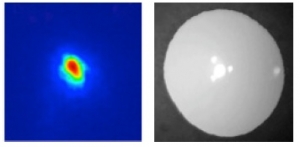 Autors: Juan M. Bueno, Guillermo Pérez, Antonio Benito and Pablo Artal
Autors: Juan M. Bueno, Guillermo Pérez, Antonio Benito and Pablo Artal
Journal: BioMedical Optics Express
Volume: 6, No. 12
Pages: 4841- 4849
Year: 2015
ISBN: 2156-7085
ABSTRACT
We compared objective Double-Pass (DP) image quality data with subjective visual parameters measured within the same modified instrument for different amounts of scatter. The original DP imaging channel of a clinical instrument was maintained intact and two additional channels were included, one for visual testing and another for tear film (TF) imaging by using a retro-illumination technique. Contrast sensitivity (CS) was compared with measurements of the Objective Scattering Index (OSI) obtained from DP retinal images corresponding to different scatter levels induced by pre-defined filters. OSI values were correlated with the change in CS for different spatial frequencies measured with the same instrument. Since TF and DP images were recorded at the same rate, this provided additional information about the dynamic spatial stability of the tear film. This new DP instrument has been proven to provide accuracy and repeatability, and to be suitable for clinical diagnosis, with a complete evaluation of the eye’s performance by a simultaneous objective and subjective assessment under the same experimental conditions.
©2015 Optical Society of America
ABSTRACT
We compared objective Double-Pass (DP) image quality data with subjective visual parameters measured within the same modified instrument for different amounts of scatter. The original DP imaging channel of a clinical instrument was maintained intact and two additional channels were included, one for visual testing and another for tear film (TF) imaging by using a retro-illumination technique. Contrast sensitivity (CS) was compared with measurements of the Objective Scattering Index (OSI) obtained from DP retinal images corresponding to different scatter levels induced by pre-defined filters. OSI values were correlated with the change in CS for different spatial frequencies measured with the same instrument. Since TF and DP images were recorded at the same rate, this provided additional information about the dynamic spatial stability of the tear film. This new DP instrument has been proven to provide accuracy and repeatability, and to be suitable for clinical diagnosis, with a complete evaluation of the eye’s performance by a simultaneous objective and subjective assessment under the same experimental conditions.
©2015 Optical Society of America
https://doi.org/10.1364/BOE.6.004841
Download paper: Impact of scatter on double-pass image quality and contrast sensitivity measured with a single instrument
